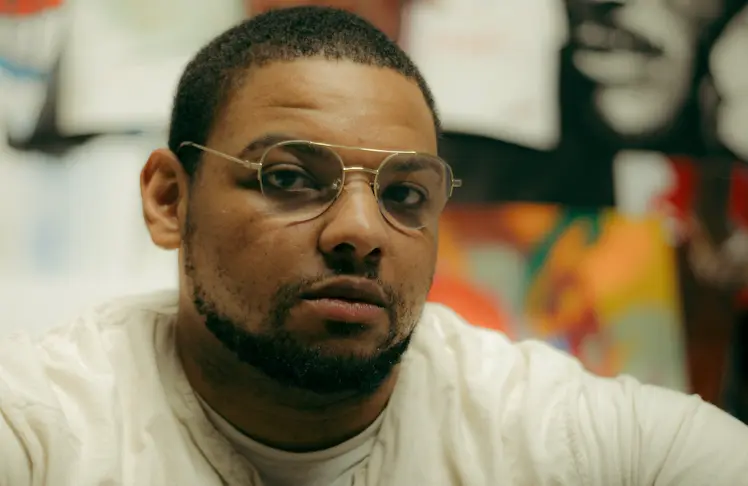
“Flint’s Still Fighting” is Word In Black’s series about the decade-long water crisis, and the resulting struggles and triumphs still transforming the majority-Black city.
When the water crisis hit Flint, Michigan, in 2014, residents were left with more than just contaminated pipes and brown, unsafe water flowing from their taps. The majority-Black city was also grappling with a profound lack of resources and opportunities. And as is so often the case in challenging times for the Black community, art became an outlet for expression, healing, and demanding accountability.
Ten years after the officials made the disastrous decision to switch Flint’s water supply from Detroit’s system to the Flint River to save money, Black artists are using their work to call for justice and document the city’s triumphs.
“Of course, there’s that feeling of dread because we still have a lot of dilapidated buildings and gray skies sometimes,” says Flint native Keyon Lovett, 34, a multi-disciplinary visual street artist, creatively known as The Art School Dropout. “But the hopeful thing is knowing on Friday that we have the Art Walk downtown. You can go to the Farmer’s Market and get some good food and see a show.”
Lovett didn’t plan to become an activist, but the water crisis changed the trajectory of his life. Around the time the crisis began, he left an arts program with Grand Valley State University in Allendale, Michigan, which is located two hours west of Flint near Grand Rapids. Lovett says he was unable to return home to Flint because the emergence of the water crisis meant there were few opportunities for artists in the city.
“I didn’t want to come home because the only work that would have possibly been available was working at UPS or General Motors, and my family already did that. I wasn’t trying to be the next lineage of Lovetts to be in the factory,” Lovett says.
Lovett stayed connected to what was happening in Flint through frequent trips home to visit friends and family — and what he saw began to show up in his art. In 2018, Lovett debuted “Home Sweet Home” at ArtPrize, an open, independently organized international art competition in Grand Rapids, Michigan. The live installation and accompanying documentary highlighted the realities for Flint residents during the water crisis.
“The installation I did was of me living in a house that was condemned, but I’m living off of six stacks of bottled water,” Lovett explains. “As the viewers of ArtPrize come in, they see me cooking, washing, brushing my teeth, and people would offer water because they’d see the stacks getting low. I’d say, ‘No. If I run out, I run out, because that’s how it is at home.’ That’s how it was. At the water centers, there would be days they had donations, and there would be days they don’t. People were stealing donations. People were breaking water machines.”
In the face of confusing news coverage and shame-dodging politicians who silenced many Flint residents, Lovett created the “Home Sweet Home” documentary that let Flint’s people speak the truth about the lack of access to safe and clean water.
“We filmed a short 10-minute documentary, and what I did was interview my family and friends and have them explain and share their stories on how the water crisis impacted the city, themselves, work, and everyday life,” Lovett says.
10 Years Later
A decade after the water crisis began, health implications from ingesting the unsafe water as well as financial burdens continue to plague residents. Lovett, who moved back to Flint in 2021, says that while there is much rebuilding left to do, the community is also beaming with progress and hope — and that is, in part, due to Black artists in the city.
“One of the reasons I moved back home is because of the renaissance of Black music, poetry, and art happening in Flint. A lot of Flint rappers, and singers, and artists are just being great. I wanted to come back home and be a part of that,” Lovett says.
In addition to his own work, Lovett says many other Flint organizations — from the Beats x Beers music tour, to Comma Bookstore & Social Club, and the creative co-op space Art At The Market — are using art to promote continued growth and healing.
Lovett and other artists in Flint follow in the footsteps of self-taught painter Clementine Hunter, who depicted plantation life through the 1800s, and renowned photographer Gordon Parks, who captured generations of movements for civil rights starting through the twentieth century. And as Octavia Butler said, “I began writing about power because I had so little.”
“It’s always important to have art that means something. Art that sheds a light and requires accountability,” Lovett says. “Even with the blight in the city, finding ways to put up murals, finding ways to have an initiative of Flint pride within the artwork, to even showcase a Flint artist, is important.”
The Future of Flint
Lovett says the water crisis briefly equalized Flint, forcing both the affluent and working-class residents to grapple with the same lack of accessible clean water. Now, he hopes the unity birthed from that shared struggle can leave Flint’s divisions behind for good as the city’s vibrant arts scene leads it into a culture of collective effort — and a brighter future.
“Just be one and leave all of the classism behind,” he says. “Just be Flint.”


















